Over the last several weeks, symptoms of wheat streak mosaic virus have been showing up in wheat fields across Kansas (Figure 1). This disease complex can be caused by several viruses, including wheat streak mosaic virus, Triticum mosaic virus, and wheat mosaic virus (high plains). These viruses are vectored by the wheat curl mite, a near-microscopic mite that survives between seasons on volunteer wheat and other grassy hosts. These grassy hosts serve as a “green bridge” for mites to survive from one wheat crop to the next. Infections may occur in the fall or spring, but fall infections typically result in the highest levels of yield loss. Although wheat streak mosaic infections can happen at any time, symptoms develop most rapidly at temperatures above 70°F. Symptoms have become more severe in Kansas over the last several weeks as temperatures have warmed. In this article, we walk through common questions about this complex of viruses.
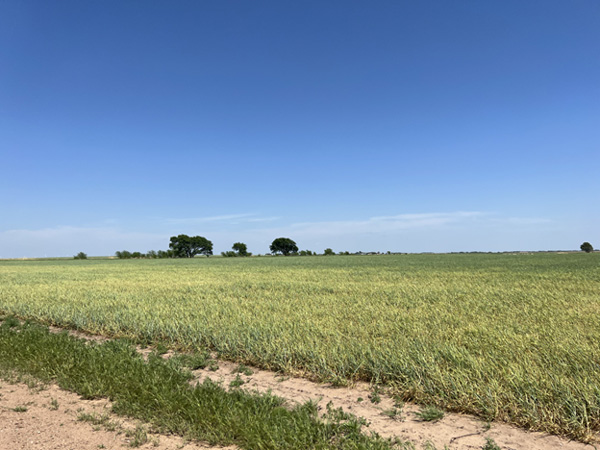
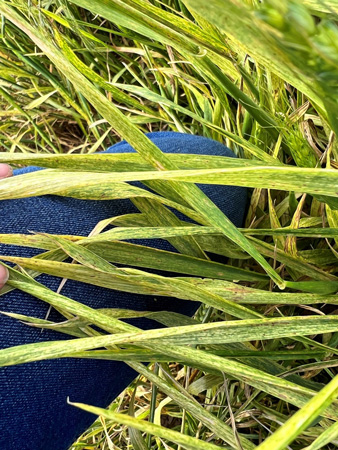
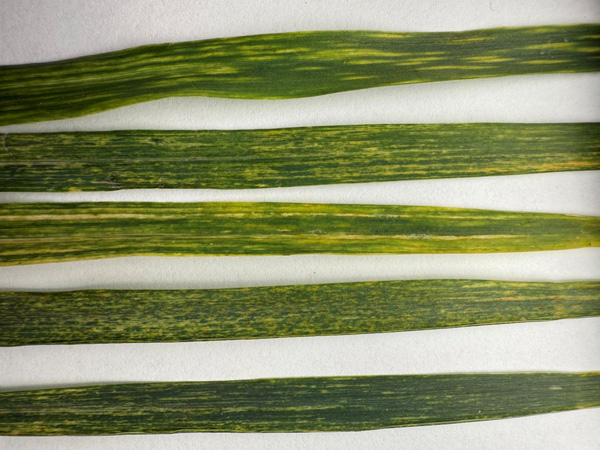
Figure 1. Field view of a field turning yellow from wheat streak mosaic complex (top) and various symptoms of wheat streak mosaic complex (bottom two photos). Symptoms may vary based on the time of infection and the variety. Photos by Kelsey Andersen Onofre, K-State Research and Extension.
Will a fungicide help with my wheat streak infection?
No. There is no evidence that a fungicide application will do anything to stop the progression of wheat streak mosaic complex or preserve yield in infected fields. Fungicides are specifically formulated to kill diseases caused by fungi (rust, leaf spots, head scab, etc.) but have no activity against viral diseases like wheat streak mosaic. In addition, fields that have moderate to severe wheat streak mosaic infections will often have reduced yield potential that will diminish the economic return from a fungicide applied to control one of those other diseases (rust, leaf spots, or head scab).
Why is the wheat streak complex so severe and widely distributed this season?
Although we are still trying to understand the extent of the damage across the state, there are a few factors that came together this season that may have contributed to the outbreak. Wheat streak complex can be more severe in years where summer moisture that favors volunteer wheat establishment is followed by a warm fall that favors mite reproduction. In 2024, although August was relatively dry, precipitation in July and September would have supported late volunteer wheat emergence (Figure 2). Wheat curl mite populations prefer warm, dry weather and reproduce at high rates between 75-85°F. These mites only survive short periods (8-10 days) when conditions are warm, but during that time, they can lay up to 20 eggs. This rapid population growth can lead to a 25% increase in population size over the course of just two weeks. In 2024, Kansas experienced a very warm fall with higher-than-normal temperatures from September through November (Figure 3). These conditions may have sustained periods of time that were highly favorable for mite reproduction and movement across fields.
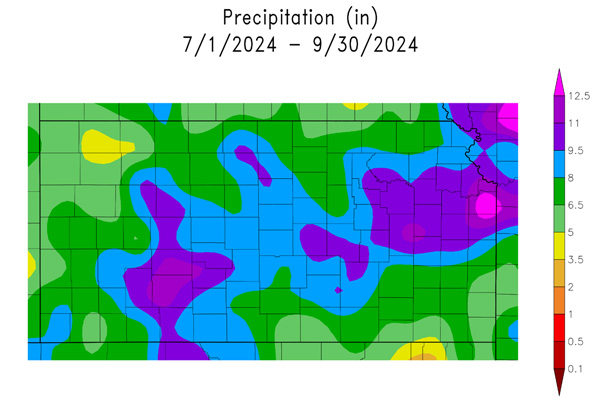
Figure 2. Total precipitation from July 1, 2024 to September 30, 2024. Source: NOAA Regional Climate Centers.
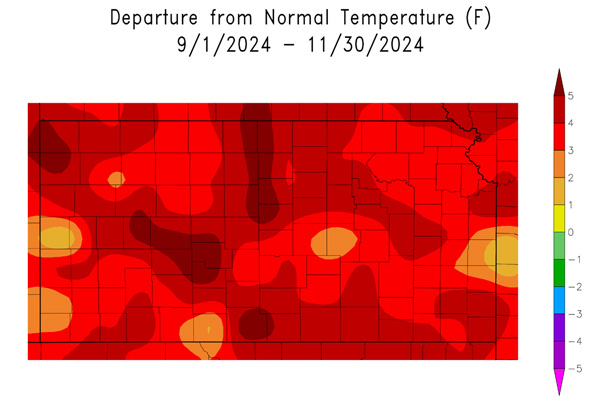
Figure 3. Departure from normal temperature for the period from September 1 to November 11, 2024. Source: NOAA Regional Climate Centers.
Is there anything I can do this season to help slow down the progression of the disease?
No. Efforts to control wheat curl mites with foliar miticides and/or insecticidal seed treatments have never proven effective and have not been shown to reduce the spread or severity of the viruses.
What can we do to prepare for the 2025 planting season?
The most critical way to prevent wheat streak complex infection is to control volunteer wheat after harvest and continue to control any secondary flushes of volunteer prior to planting. After harvest, there will be millions of wheat curl mites active in most wheat fields in Kansas. These curl mites will move off growing wheat as the green tissue dries down and dies. After moving off the existing wheat at or near harvest time, the mites need to find green tissue of a suitable host or they will die (death of the whole population will take approximately 2 weeks). The highest risk fields are those that have experienced hail and pre-harvest germination of volunteer wheat. We also need to watch for hidden volunteer wheat in summer crops and cover crops. Although curl mites prefer wheat, they can also survive the summer on other grass species (https://bookstore.ksre.ksu.edu/pubs/wheat-streak-mosaic_MF3383.pdf). Avoid planting wheat early to reduce the length of time mites have to increase their numbers and transmit disease.
How much yield loss can I expect from wheat streak complex?
Yield losses to wheat streak complex are influenced by several factors, including the timing of infection, variety, and the number of viruses affecting a field. Fall and early spring infections typically result in the highest levels of yield loss, while late infections result in the lowest yield reductions. We now know that infections with multiple viruses (WSMV + TriMV) result in higher yield losses than when plants are only infected with a single virus. Variety selection can also have an influence on yield losses. Although there are no perfect varieties, some hold up better than others under high disease pressure. K-State’s most current ratings for the wheat streak mosaic complex can be found here: https://bookstore.ksre.ksu.edu/pubs/kansas-wheat-variety-guide-2024_MF991.pdf
How can I test for these viruses?
It can be important to distinguish wheat streak complex from other wheat diseases. See this recent eUpdate article for information on how to best submit a sample for wheat virus testing to the K-State plant disease diagnostic lab: https://eupdate.agronomy.ksu.edu/article/k-state-plant-disease-diagnostic-laboratory-fee-adjustments-634-7.
Additional resources for the wheat streak mosaic virus and triticum mosaic virus:
Wheat Streak Mosaic Virus: https://bookstore.ksre.ksu.edu/pubs/wheat-streak-mosaic_MF3383.pdf
Triticum Mosaic Virus: https://bookstore.ksre.ksu.edu/pubs/triticum-mosaic_EP145.pdf
Kelsey Andersen Onofre, Extension Wheat Pathologist
andersenk@ksu.edu
Romulo Lollato, Wheat and Forages Extension Specialist
lollato@ksu.edu
Jeanne Falk Jones, Multi-County Agronomist
jfalkjones@ksu.edu
Anthony Zukoff, Extension Entomologist – Southwest Research and Extension Center
azukoff@ksu.edu
Tags: disease volunteer wheat wheat wheat streak mosaic wheat curl mite